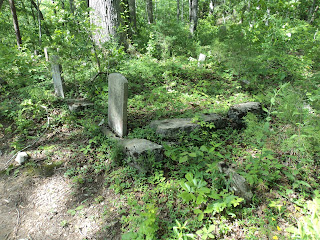Hike Location: Spring Valley Nature Center and Heritage Farm
Geographic Location: Schaumburg, IL (42.02810, -88.05216)
Length: 2.1 miles
Difficulty: 1/10 (Easy)
Date Hiked: May 2019
Overview: A nearly flat loop exploring all points of
interest in the nature center.
Center Information: http://www.parkfun.com/spring-valley
Directions to the trailhead: On the west side of
Chicago, take I-290 to SR 72 (exit 1B).
Exit and go west on SR 72. Drive
SR 72 west 0.7 miles to Meacham Road and turn left on Meacham Rd. Drive Meacham Rd. south 0.7 miles to
Schaumburg Road and turn right on Schaumburg Rd. The signed entrance for Spring Valley Nature
Center is 0.3 miles ahead on the left.
Park in the large concrete lot that is located at this entrance.
The hike: Established
in 1983 as a living history museum, Spring Valley Nature Center and Heritage
Farm protects 135 acres of forest and prairie in suburban Chicago. The site is named for the abundance of
springs that flowed in this area until the 1950’s, when quarrying operations gone
amiss accidentally but permanently diverted all of the springs’ water. The site’s centerpiece is the Volkening
Heritage Farm, a re-creation of a Schaumburg German-style farm that features
livestock, crops, equipment, and furnishings from the 1880’s. The Center is owned and maintained by the
City of Schaumburg, and it represents a great resource for the people of
Chicagoland.
In addition to the Heritage Farm,
the site features a playground, the 1920’s era Merkle Log Cabin, and the Vera
Meineke Nature Center, which contains some nice exhibits about local flora and
fauna. For hikers, Spring Valley Nature
Center and Heritage Farm offers 3 miles of nearly flat hiking trails. Many routes are possible through the Center’s
trails, but the route described here takes you to every major point of interest
while doing minimal retracing of steps.
 |
| Trailhead behind Nature Center |
From the parking lot, walk through
the Vera Meineke Nature Center building (or around it if it is closed) and walk
past an old silo that has been transformed into an observation tower. Metal spiral steps inside the silo take you
to the top of the tower, which provides a nice birds-eye view of the
property. The Center’s main trailhead is
located near the southwest corner of the Nature Center building, and 4 trails
start here. This hike starts on the asphalt
trail that exits at a soft angle to the left.
This trail forms an oval-shaped loop around a prairie area, and the
Center’s Illinois Habitats Trail also starts on this route.
After walking 1/3 of the way around
the oval, turn left to leave the asphalt trail and cross a boardwalk over a wet
area. A grass/mulch trail forms a small
loop beside this wetland. At 0.3 miles,
you reach a floating dock that overlooks tranquil Merkle Pond. I saw a blue heron and several turtles in
this pond when I came here on a late afternoon in mid-May.
 |
| Merkle Pond |
Continuing around the wetland loop,
quickly you reach another asphalt trail, where you need to turn left to
continue this hike. This asphalt trail
heads due west and crosses a service road for the Merkle Log Cabin before reaching
the Illinois Heritage Grove. True to its
name, the Illinois Heritage Grove is a collection of trees that are native to
Illinois. Interpretive signs help you
identify the various trees.
Exit the grove to the left (south)
via a mulch trail. The mulch trail heads
south through a narrow strip of woods with the West Branch of Salt Creek on
your right and the Merkle Log Cabin service road on your left. A boardwalk provides a nice view of the gurgling
creek.
 |
| West Branch of Salt Creek |
At 0.6 miles, you reach a
complicated but well-signed trail intersection.
This hike will eventually turn right to head for the Volkening Heritage
Farm, but first turn left and walk a short distance downhill to reach the
Merkle Log Cabin. The cabin and pond are
named for Frank Merkle, who purchased this land in the late 1930’s. The cabin features some high-end log
construction, and it occupies a shady scenic spot along the shore of Merkle
Pond. This spot could be in remote
northern Michigan or Minnesota were it not for noise from nearby highways and
O’Hare airport.
 |
| Merkle Log Cabin |
Back at the complicated trail
intersection, continue west to cross Salt Creek and quickly reach the Volkening
Heritage Farm. The farm comes complete
with a large red barn, a homestead featuring German-language signage, and live
cows. Walk through the north end of the
farm and follow signs for the Plum Grove Road parking area.
 |
| Barn at Volkening Heritage Farm |
 |
| Homestead at Volkening Heritage Farm |
Just past 1 mile, you approach the
Plum Grove Road parking area. Angle left
to begin the mulch trail that leads to Bob Link Arboretum. Virginia bluebells bloomed beside this path
on my hike. At 1.25 miles, you reach Bob
Link Arboretum, a grassy area dotted by trees and shrubs. Turn right to begin the loop around the
arboretum.
 |
| Bob Link Arboretum |
Stay right where side trails exit
left to short-cut the loop, but avoid narrow trails that exit right and lead to
private property to the south. At the
east end of the arboretum, turn right to exit the arboretum and head into a
large prairie area. This area was rather
dull on my mid-May visit but should feature nice prairie wildflowers in late
summer. Where the dirt trail intersects
a paved road, turn right on the paved road to head back to the Schaumburg Road
parking area. The sunny paved road
passes a Play Pocket, a small play area for kids that features natural items
such as logs and stones, before returning you to the parking area to complete the
hike.



















